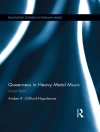Opens up significant paths for conversation about how musical concepts, practices and products were shaped by interrelationships between culture and commerce.
Art and money, culture and commerce, have long been seen as uncomfortable bedfellows. Indeed, the connections between them have tended to resist full investigation, particularly in the musical sphere.
The Idea of Art Music in a Commercial World, 1800-1930, is a collection of essays that present fresh insights into the ways in which art music, i.e., classical music, functioned beyond its newly established aesthetic purpose (art for art’s sake) and intersected with commercial agendas in nineteenth- and early twentieth-century culture. Understanding how art music was portrayed and perceived in a modernizing marketplace, and how culture and commerce interacted, are the book’s main goals.
In this volume, international scholars from musicology and other disciplines address a range of unexplored topics, including the relationship of sacred music with commerce in the mid nineteenth century, the roleof music in urban cultural development in the early twentieth, and the marketing of musical repertories, performers and instruments across time and place, to investigate what happened once art music began to be understood as needing to exist within the wider framework of commercially oriented culture. Historical case studies present contrasting topics and themes that not only vary geographically and ideologically but also overlap in significant ways, pushing back the boundaries of the ‘music as commerce’ discussion. Through diverse, multidisciplinary approaches, the volume opens up significant paths for conversation about how musical concepts, practices and products were shaped byinterrelationships between culture and commerce.
CHRISTINA BASHFORD is Associate Professor of Musicology at the University of Illinois.
ROBERTA MONTEMORRA MARVIN is Director of the Opera Studies Forum in the Obermann Center for Advanced Studies at the University of Iowa, where she is also on the faculty.
CONTRIBUTORS: Christina Bashford, George Biddlecombe, Denise Gallo, David Gramit, Catherine Hennessy Wolter, Roberta Montemorra Marvin, Fiona Palmer, Jann Pasler, Michela Ronzani, Jon Solomon, Jeffrey S. Sposato, Nicholas Vazsonyi, David Wright
表中的内容
Introduction. The Idea of Art Music in a Commercial World – Christina Bashford
Selling ‘Celebrity’: The Role of the Dedication in Marketing Piano Arrangements of Rossini’s Military Marches – Denise Gallo
Creating Successes and Forming Imaginaries: The Innovative Publicity Campaign for Puccini’s
La bohème – Michela Ronzani
Novello, John Stainer and Commercial Opportunities in the Nineteenth-Century British Amateur Music Market – David C.H. Wright
Jenny Lind, Illustration, Song and the Relationship between
Prima Donna and Public – George Biddlecombe
A German in Paris: Richard Wagner and the Masking of Commodification – Nicholas Vazsonyi
Conductors and Self-Promotion in the British Nineteenth-Century Marketplace – Fiona M. Palmer
‘What The Piano[la] Means to the Home’: Advertising of Conventional and Player Pianos in the
Saturday Evening Post and
Ladies’ Home Journal, 1914-17 – Catherine Hennessy Wolter
Art, Commerce and Artisanship: Violin Culture in Britain, c. 1880-1920 – Christina Bashford
Read All About It! Ancient Greek Music Hits American Newspapers, 1875-1938 – Jon Solomon
Selling a ‘False Verdi’ in Victorian London – Roberta Montemorra Marvin
Schicht, Hauptmann, Mendelssohn and the Consumption of Sacred Music in Leipzig – Jeffrey S. Sposato
The Business of Music on the Peripheries of Empire: A Turn-of-the-Century Case Study – Hilary J Grainger
‘Disguised Publicity’ and the Performativity of Taste: Musical Scores in French Magazines and Newspapers in the Belle Epoque – Jann Pasler












